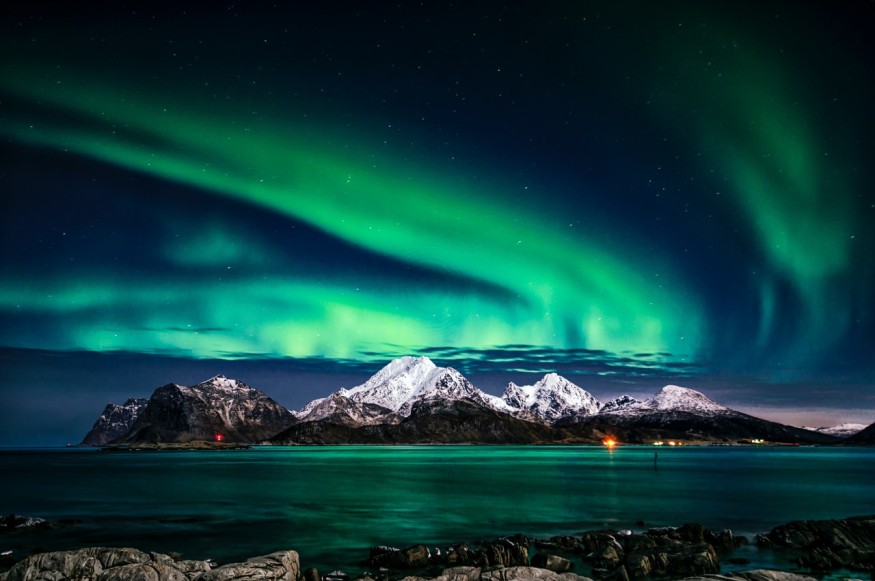The U.K. Met Office space weather forecasting center stated Wednesday that a solar storm that burst from the sun on Monday might intensify northern light displays over the north pole just ahead of Santa's journey this weekend.
A coronal mass ejection (CME), is a violent outburst of magnetically charged particles and plasma from the sun's outer atmosphere, the corona, that triggered the solar storm. CMEs can cause geomagnetic storms that interrupt satellite systems and knockdown power grids if they are directed at Earth. The rise of auroras in the regions near the North and South Poles, where these amazing displays occur, is a more favorable side consequence of these phenomena.
Glasglow World said that the aurora borealis results from the interaction of the Earth's magnetic field with charged particles released by the sun. The sun produces its own solar wind, which discharges charged particles. The particles then swirl around the magnetic fields of the Earth.

Northern Lights on Christmas Due to CME
The CME that exploded from the sun at 6:36 a.m. EST (1136 GMT) on Monday is likely to hit Earth on Thursday (Dec. 23). According to Spaceweather.com, it was caused by a massive M1.9-class solar flare that erupted from a sunspot known as Active Region 2908.
"The auroral oval is likely to be slightly enhanced at high latitudes from the 22nd to 24th due to coronal hole geomagnetic activity enhancement and the chance of a weak coronal mass ejection arriving on the 23rd," the Met Office wrote on its website.
The Sun has been busy lately with active regions keeping us on our toes before the Holidays!🧐🎄The ESA #SpaceWeather Networks A-Effort solar flare forecasts predicts high probabilities of significant flares over the next 24hr✨👀
— ESA Space Weather (@esaspaceweather) December 21, 2021
🌐https://t.co/wlcWTSS4QQ#SpaceSafety pic.twitter.com/svAKCeWThW
ALSO READ : Solar Storm Warning: Sun Might Release Big Flares, Boost Northern Lights Before Christmas
According to the European Space Agency's (ESA) Space Weather Network, the sun has been particularly active in the last week, with multiple active zones sprouting up on its scorching surface in the run-up to Christmas.
Met Office also added that the geomagnetic storm caused by the Monday CME is only predicted to be mild. When charged particles from the sun collide with the planet's magnetic field, geomagnetic storms occur. These particles will be redirected above the poles by the Earth's magnetic field lines, which is why we observe auroras in these areas.
Northern lights are best observed as far north as possible, in any location ringing the Arctic, such as northern Canada, Iceland, and Greenland, the Scandinavian nations, Russia, and Alaska (and any bits of water in between). Between 10 and 20 degrees, latitude is the greatest place to observe them. They happen all the time, but the brightness of the sun washes them away throughout the day. NASA has a helpful tool for predicting northern light occurrences and determining the best location on Earth to view them.
Northern Lights: Aurora Borealis Explained
According to Live Science, the northern lights are natural phenomena that occur when charged sun particles collide with oxygen and nitrogen molecules in the atmosphere, causing them to ionize and shine. Only high northern latitudes are likely to observe these lights, which can range from a faint glow on the horizon to billowing green and crimson sheets filling the sky.
The northern lights may take many different forms and colors. The most prevalent variety is a general white "haze" or static light just above the horizon. The lights may be seen straight overhead in more spectacular presentations, forming billowing, undulating curtains, and sheets of blue, green, and red. The red hue, which is the most unusual of the colors, is caused by highly energetic particles colliding with oxygen in the upper atmosphere. According to NASA, the blues and greens are caused by particles colliding with nitrogen at lower altitudes of the atmosphere.
Contrary to common belief, it does not have to be chilly to view the northern lights. However, because they can only be seen at night and at the northernmost latitudes, when there is little - and often no - sunshine during the winter months, you'll need to dress in layers if you want to see the northern lights.
RELATED ARTICLE : Biggest Geomagnetic Storm Hit Earth 150 Years Ago: What Have We Learned? And Are We Ready for the Next One?
Check out more news and information on Space in Science Times.










